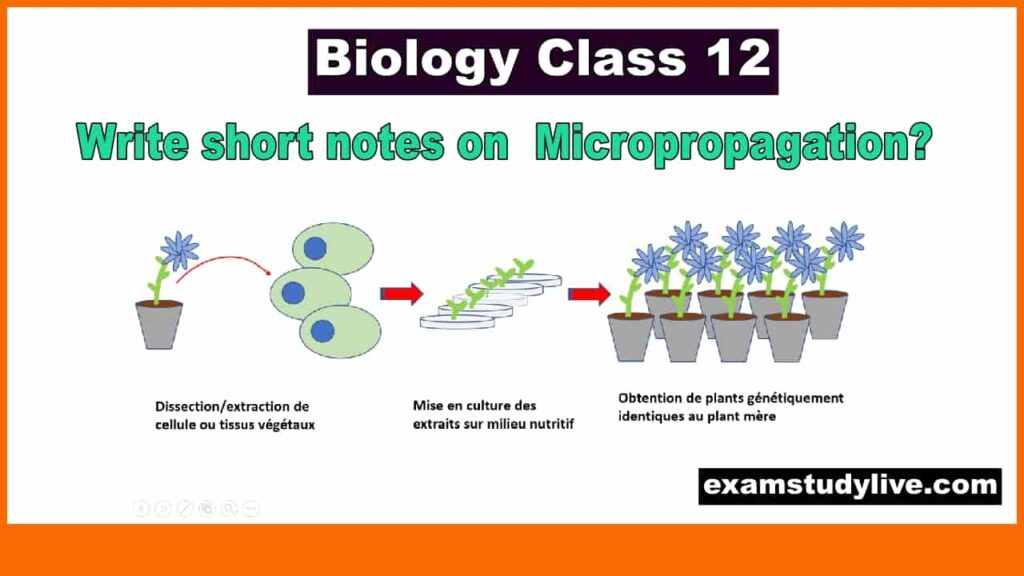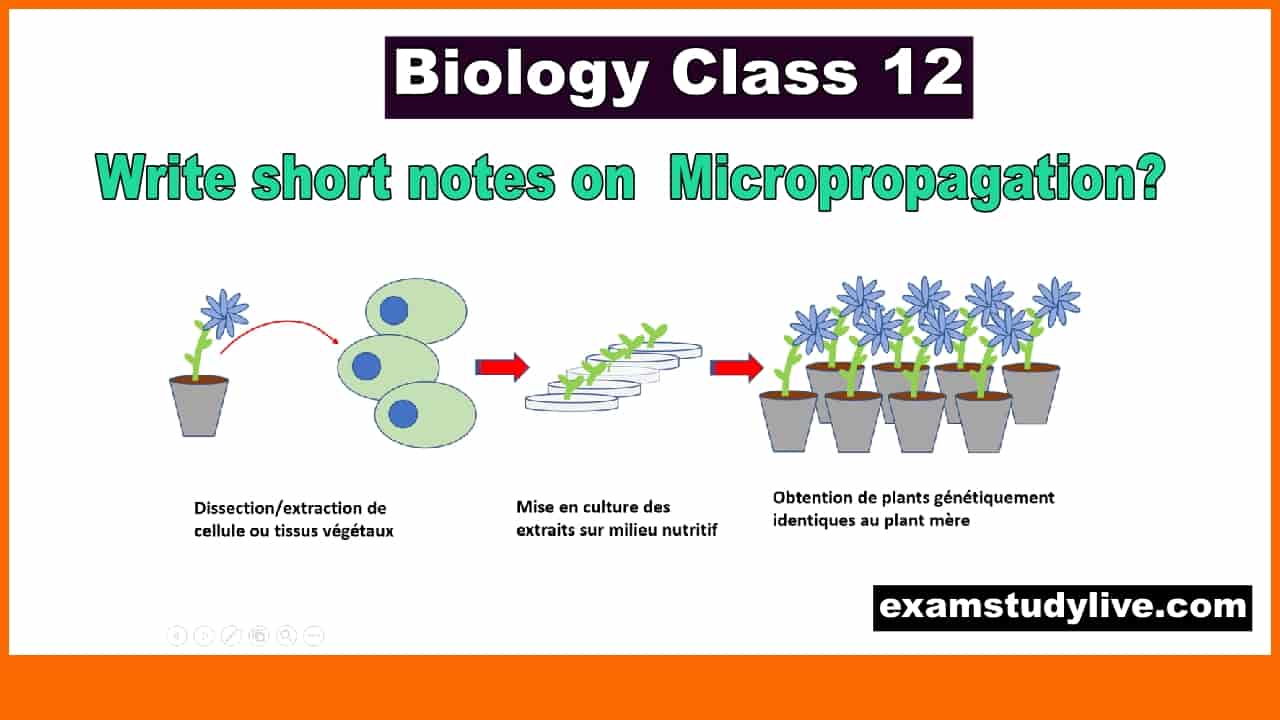Micropropagation Class 12 is an important topic of chapter 1 of unit vi of reproduction. in this article, we briefly describe short notes on micropropagation
Micropropagation Definition
Micropropagation is the artificial process of producing plants vegetatively through tissue culture or cell culture techniques. In this artificial process of propagation, plants are produced in-vitro by the asexual means of reproduction or by vegetative propagation.

Shortly Micropropagation is a technique for the production of many plants that are clones of each other.
This process is similar to the rooting of plant cuttings and is, in a way, another method of vegetative propagation of plants. However, it differs from the conventional procedure
since it is carried out in an aseptic condition and requires an artificial nutrient medium.
In a short span of time, a large number of shoots develop from the axillary buds through a process called axillary bud proliferation. Each growing point is then subcultured to give rise to shoot. This phenomenon is called adventitious shoot formation.
Example of Micropropagation
Examples of micropropagation such as tea, coffee, oil palm, date palm, coconut, fruit yielding plants like papaya, banana, citrus, and apples. Significant progress has also been achieved in developing protocols of the micropropagation of tree species.
Mass propagation, in vitro, of teak, Eucalyptus spp., sandal, wood, different species of bamboo, and many other trees has been successfully done.
Types Of Micropropagation
The process is carried out artificially of producing plantlet involves 5 different methods such as
- Meristem Culture
In meristem culture, meristematic tissues are used as explant for culturing purposes. Meristematic tissues are the type of tissues that can continuously divide and produce new cells.
- Callus Culture
A callus is an undifferentiated mass of tissue. In vitro, the callus formation is induced by placing a piece of tissue in a growth culture media under favorable conditions.
- Embryo Culture
Embryo culture is the isolation of immature or mature embryos and cultures them in a suitable growth media under favorable conditions.
- Protoplast Culture
Protoplast is a spherical naked living cell without a cell wall. It is obtained by stripping the cell wall of plants by using chemical, mechanical, or enzymatic processes.
Micropropagation Steps
Stages Of Micropropagation are divided in five parts such as
Stage 0 = Selection of an explant
Stage I =Culture initiation and establishment
Stage II = Shoot multiplication
Stage III= Rooting of the shoots
Stage IV= Transfer of plantlets in the greenhouse environment
A technique Of micropropagation is somatic embryogenesis.
somatic embryogenesis is the technique of raising somatic embryos in vitro by culturing somatic cells. The embryos derived from somatic cells are called somatic embryos.
Embryo rescue is the technique of embryo development in vitro when the embryos are likely to get abort early.
Somatic hybridization is the production of hybrid plants through the fusion of protoplasts of two different plant species or varieties.
Since micropropagation is the clonal propagation using tissue culture, a technique of micropropagation is somatic embryogenesis in which somatic embryos are raised by culturing of somatic cells.
Micropropagation Of Banana, Potato
Some species of potato, Cassava, sugarcane, and banana are severely and chronically affected by viruses. The yields of these crops can be increased significantly by planting disease-free stocks.
Potato is of most important and widely grown food crop in the world. But it is susceptible to many viral pathogens, some of which may be present without perceptible symptoms.
The pathogens cause a gradual decrease in the vigor and yield of potatoes. Eradication of viruses can be achieved by employing micropropagation techniques where healthy meristematic buds are cultured.
More than 500 plants can be obtained in about three to four months starting from a single meristem. By manipulating the medium composition, light intensity, and temperature, plantlets can be induced to producemicrotubers.
These disease-free microtubes can be grown under controlled conditions in soil to form mini tubers. The mini tubers can be planted directly in the field to raise a disease-free crop.
Also read Taxonomy hierarchy And Systematics Class 11 Notes Biology Chapter 1
Benefits Of Micropropagation
This method is generally practiced for ornamental, fruit, and crop plants. This is useful because
- The healthy propagules can only be obtained (pathogen-free).
- Rapid rates of multiplication can be ensured.
- Development of plant materials with desired traits and their maintenance in a small space can be done.
Application/Advantages Of Micropropagation
Benefits of micropropagation
- The micropropagation method of seed production is particularly important in yields because hereditary preservation is required for seed formation.
- A limited amount of plant tissue is sufficient to produce a large number of clones using microbiology.
- Micropropagation techniques provide a good selection in contrast to plant species that show protection from traditional mass multiplication practices.
- Expansion of in vitro shares should be possible every year. In addition, a nursery can consistently make natural materials, details, and species of wood.
- High yields of plants and expanded power are obtained on horticultural species.
- Rapid global trade in plant products without the disease. This technique reduces the time required for separation.
- Larger plant sizes can be placed at smaller intervals. It helps in warding off dangerous organisms and germs.
Apart from the application of micropropagation techniques for generating true-to-type planting material from elite genotypes, micropropagation holds special significance in situations where rapid bulking of extremely limited stock material is required.
The desired genetic gains achieved through plant breeding can be multiplied several-fold on an economic and rapid time scale.
Disadvantages Of Micropropagation
Micropropagation isn’t operations generally the ideal method for increasing plant conditions that restrains its utilization include
- It is pricey and can have a work cost of more than 70.
- Some plants are hard to sterilize of contagious life forms.
- A monoculture is delivered after micropropagation, prompting the absence of by and large ailment versatility, as all descendants’ plants might be helpless against similar contaminations.
- A contaminated plant test can deliver tainted descendants. This is phenomenal as the stock plants are deliberately screened and checked to forestall refined plants tainted with infection or growth.
- Sometimes plants or cultivars don’t work out as expected to type in the wake of being tissue refined. This is frequently reliant on the sort of explant material used during the commencement stage or the consequence of the age of the phone or propagule line.
- Not all plants can be effectively tissue refined, frequently in light of the fact that the correct model for development isn’t known or the plants produce auxiliary metabolic synthetics that trick or slaughter the explant.

